The story of Halo 2's iconic multiplayer maps: tight deadlines, a tiny team, and a visit from Napoleon Dynamite
An oral history of some of the best multiplayer maps ever designed with two Bungie veterans.
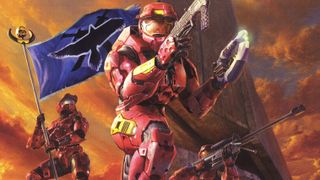
Halo 2's multiplayer popularized Xbox Live almost overnight when it launched in November 2004. It was a phenomenon. Console multiplayer suddenly caught up to PC and even leapfrogged it in influence—before long, Halo 2 innovations like matchmaking would become the standard. Fans played Halo 2 online right up until the very end in 2010, when Microsoft shut down its servers. Now that it's part of the Master Chief Collection on PC, Halo 2 has a chance to live on for many, many years to come. And it deserves to—even if it looks and feels dated compared to most of today's shooters, Halo 2 still contains some of the finest multiplayer maps ever made.
Many of those maps were designed by two people: artists Chris Carney and Steve Cotton, who worked closely together on the maps of both Halo 2 and Halo 3.
I got the two of them together to talk about the making of Halo 2, and specifically the stories behind a few standout maps: Zanzibar, Lockout, Containment, and Terminal.
Making maps, Halo-style
Chris Carney: On Halo 1 we built anything we could get our fingers on. When I joined Bungie in May 2001 they had just gone to E3, and I guess things hadn't gone very well. They had even talked about cutting multiplayer before E3. At E3 we showed Blood Gulch—it was very flat, you couldn't flip the Warthog. People were like, 'meh, it was alright.'

I got hired as a contract artist and we just built what we could, got the game out there. So for Halo 2 we were like, let's be a little more structured about what we're building. We came up with a matrix: We need small maps, medium maps, large maps. With large maps we want our dream chaos, 8v8, tanks, banshees, everything. With smaller maps, 1v1 up to potentially 4v4.
The other thing we tried to do, unlike Halo 1, with each map we wanted to aim at a primary game type and a secondary game type. With Halo 1, we're like "Every map works for everything" which means nothing really works that well. For Halo 2 we said we'll build a map and it'll primarily be a Slayer map, and you can also play CTF on it, and we'll really try to design towards both of those goals. You can still play Territories on it, but it won't be an ideal Territories map. As we had that matrix of categories, all these maps we wanted to build, each one we then assigned a primary and secondary gametype, and that gave us a rough framework to design within. It also allowed us to really determine whether or not a map was good.
Steve Cotton: I actually came on March 1 [2004], the year Halo 2 shipped. So it sounds like I came on pretty late because Halo 2 was a three-year project, but if you know anything about the way we made Halo… it was pretty late, but there were only 2-3 maps done at that point. And we had to make the rest of the Halo 2 maps from March to August, maybe? It was very quick.
Comic deals, prizes and latest news
Sign up to get the best content of the week, and great gaming deals, as picked by the editors.
Chris: We knew everything we wanted to make, we had a bunch of grey boxes, but they were not even remotely close to done, or arted up or anything. I was the only one really working on maps formally. Max Hoberman, the design lead, was doing spawns and weapons and all the UI and Xbox Live integration which was brand new for us. When Steve arrived there was a golden light around him as he walked in…
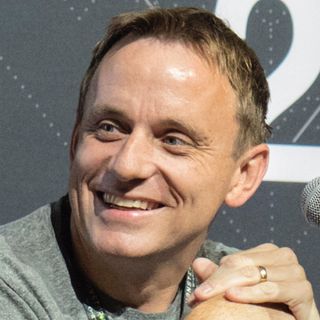
Steve: They didn't tell me that when I got hired.
I was a multiplayer environment artist, I believe is what my title was. It's funny, I interviewed as a singleplayer artist, as an environment artist for the campaign. Chris and Max were in the interview loop, and they hijacked the interview and next thing I knew I was talking to them about multiplayer maps.
Chris: Yeah. You were awesome because you just wanted to help any way you could. It wasn't that we were just desperate for help. At Bungie the environment artists also did level design. We needed an environment artist who was also sensitive to design constraints and could design, and Steve had done that on other games so he was a terrific fit.
Steve: I came in with a lot of experience working on Rainbow Six, and I'd just gotten off Amped, the snowboarding game, which Chris had played a lot of.
Chris: Loved it.
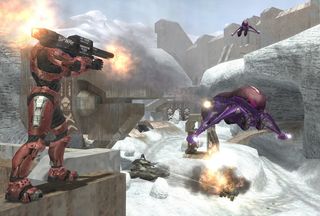
In their roles as artists and designers, Carney and Cotton created the bulk of Halo 2's 12 launch multiplayer maps. Considering the multiplayer's impact and longevity, it was a surprisingly small team. The majority of Bungie's staff were dedicated to the campaign, but other artists would jump in to help finish maps when they really needed it. To Carney, it made sense that the focus was on the campaign.
Chris: Bungie was always, and still is, driven by the good singleplayer narrative. We wanted that story of the Chief to be awesome, we wanted those worlds to be awesome, so it made sense that that whole emotional environment experience needed to be amazing. And everyone was helping us play multiplayer. We never had a shortage of people who wanted to help us test. I don't think we ever thought about it in terms of 'This [multiplayer] might be really loved by a lot of people.' I think we just didn't want to let the team down. We were just trying to get our stuff done so it didn't look terrible. That was the bar we were shooting for: Not looking terrible.
If you haven't picked up on it yet, Carney is jokingly self-deprecating.
Steve: A lot of the manpower spent making videogames in general is on the polish and the art and the extra layers that make it gorgeous and beautiful. We didn't have as much time and manpower to do that side of it, but what that allowed us to do was spend more time making all those levels as fun as we needed them to be. We could've thrown more bodies at it, but in some ways that just makes them more complicated and expensive and harder to manipulate. I don't know what I would've changed about it. For everybody else's part, they'd chip in and we'd get support when we needed it to get it out the door.
Chris: I agree absolutely. Because it was just us, and we were both environment artists, we could still be changing things all the way. We could constantly be dialing in even little nuanced parts of the gameplay just to make it feel right. [Today] you want to get the gameplay stuff done six months before the thing is due because then the artists need to get on it and get it to the bar that games are at these days.
Steve: You just can't make stuff as fast as we were making it back then, because of everything that has to go into it.
Chris: That was some of the most fun work I've ever done on a game. You didn't have a choice: You just had to sit there and keep building, keep designing.
Zanzibar, aka "Steve World"
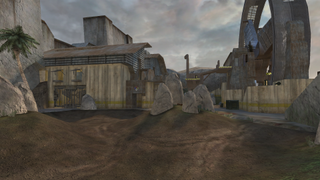
Perhaps the definitive attack/defend objective map in Halo history, Zanzibar is packed with cool features. The defense's base has a gate that can be opened to let in an attacking Warthog. A giant wheel in the center anchors the map, giving attackers a sneaky route to the base's top floor and a hidden energy sword. Snipers can duke it out laterally across the map, while the open spaces showed off the rocket launcher's ability to track vehicles. If it feels packed and unusually dense for a Halo map, that's because it was designed to showcase every fancy new feature Halo 2 had to offer. And it was mostly made in just a few weeks.
We gotta go to E3, we gotta show a map... We have nothing. But to make it better, we have six weeks.
Steve Cotton
Steve: I remember my first week realizing exactly what we had to do, and how quickly we were going to have to do it. Those were some of the most fun times I had working on maps, with Chris and Max [Hoberman] during that phase. My biggest recollection was, within a week of me starting, Chris came to my desk and was like 'Hey, we have an opportunity…'
Chris: (Laughs) Always a loaded sentence.
Steve: So I got excited. (Laughs) Then he's like: 'We gotta go to E3, we gotta show a map, and it's gotta do all these things: Show off vehicles, dual wielding, moving objects, Capture the Flag, all of this stuff.' And I was like 'All right, this sounds exciting! Where are we right now?'
And he's like: 'We have nothing. But to make it better, we have six weeks to do it.'
He put pen to paper, and as far as I'm concerned he started that week, with Zanzibar, and a week later we were both working on the map.
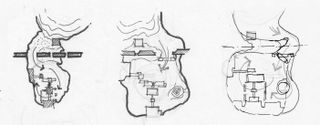
Chris: That's absolutely true. While I was trying to figure things out, you were already blocking it in, so we were able to push ideas back and forth and I wasn't just speaking to myself in a dark closet. I had someone to bounce good ideas off of. We had to get that thing together really really fast.
Steve: These maps generally took us months to make, iterating in the playtests, massing it out, getting feedback, iterating some more, and then going into what we call 'architecting' where we detail the geometry more and then texture it. It's a months-long process generally and we had six weeks to get this thing into a situation where we could show it as E3. Those were some pretty intense weeks.
Chris: All those things are back of the box features. Hey, we have Havok physics! The wheel had that colored lighting on it...
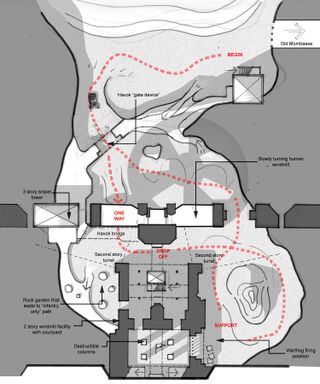
Steve: I remember us playing with shaders and trying to get that iridescent quality of the metal. We were still on a portal engine. This was an exterior space that was going to have a lot of complexity, and we had to think pretty hard about how we were going to divide the sightlines.
Chris: Breakable glass! We'd never done these [sorts of things] before. Even the lights hanging [in the base] had a gel, and you could see it on your first person arms, so we had to create this really tight little corridor where if you knocked the light the gel would shadow your arms, which was yet another technology we were showing off.
Steve, didn't you just have a baby in this period?
Steve: My wife was pregnant. When I moved up to Seattle we found out almost that same week she was pregnant. So I had a baby on the way, but in fact I don't think Zanzibar would've happened if I'd actually had the baby!
We had to divide and conquer. That was the way we were able to get this done. Chris divvied it up. I did a bunch of the exterior stuff and the oceanline and the sea wall, and he did the base, and we sorta met in the middle close to the wheel.
Max Hoberman and Joseph Staten unveiled Halo 2's multiplayer at E3 2004 using Zanzibar. It was a polished presentation that gave no indication of how rushed the map had been. The battle rifle's firing mode and the rocket launcher's tracking were both changed significantly between June and the game's release in November. According to Carney, the map also didn't have a name until a few days before E3. They called it Steve World.
Chris: We were playtesting in the mornings and the evenings so we were getting tons of feedback. Max was working with us helping dial in weapons. We had rocket tracking on the Warthog so we were trying to get that to feel really good. I do remember with like four days left before we had to be done for E3, we realized there was no way in heck we were going to even get the whole thing textured, let alone looking good enough to put on the E3 floor. So then all the environment artists dogpiled it for like 48 hours with us and did the majority of the art, which made it look really nice.
The idea with Zanzibar was we wanted to show off that primary gametype, single-flag CTF. You could play that in Halo 1 but we'd never designed a dedicated map for it. So the idea was attackers started on the beach and then had two layers of defense to get to the base..
That [sniper] tower, on the right, is 100 percent stolen from Ascension. We took the tower from Ascension, ripped that out, and slammed it in the corner.
One of my favorite memories of Zanzibar is pulling off clutch flag passes, as an attacker, by tossing the flag up to a teammate in this little cubbyhole in the seawall. You could also grenade jump up to it with good timing.
Steve: I don't know if that was intentional right out of the gate in Carney's initial design, but I remember it pretty early—it's always challenging giving people interesting ways to return a flag, because they don't have a weapon. You want to give them a shortcut but they have to work for it. That hole was our best way of trying to create that. I remember spending a lot of time trying to get the height of that opening to be just right. We designed it to be able to throw the flag into it, and have somebody else get it.
Chris: You're totally right. Someone had to be waiting, but the idea was you'd throw it.
Steve: In playtesting and figuring out the physics, people started being able to barely grenade jump that. I remember spending a lot of time making it so that if people thought they should be able to grenade jump, and we thought that was cool, making it be a thing.
Lockout
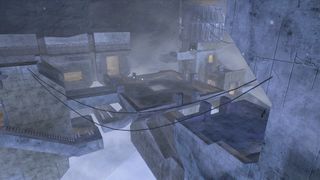
Lockout was one of the very first maps Chris Carney designed for Halo 2. In fact, it was one of only three maps that was featured in an internal Halo 2 alpha a few months before E3 2004. It instantly became a fan favorite upon release, offering a small but complex space. It felt like a PC shooter deathmatch map, and for good reason, it turns out.
Chris: This was definitely in the 'small' column. We wanted a map that really excelled at Slayer. Part of the idea with Lockout was you could see people at various distances but couldn't immediately interact with them. You'd see a guy in a tower for a sec, but then he'd disappear. It created an interesting atmosphere for hide-and-go-seek.
It is directly influenced by a Quake map called DM6. DM6 was this three-level map that folded back in on itself, that also had a similar characteristic where everything fed back into the middle. We also just iterated on this map so much. It was one of the first things we got together. When Steve arrived we'd already had it in the beta, and we iterated on it more before it shipped. We literally spent close to three years on that map. Ascension was another map like that, we just spent a ton of time on it.
Lockout is directly influenced by a Quake map called DM6.
Chris Carney
Someone brought in one of these consoles they had at stores like Gamestop, an Xbox and two controllers in this kiosk. We set this up at the studio and then we could feed builds into it. People used to play Lockout and Ascension, multiple games a day, they'd just stop by and play against each other. Then you got really good feedback. These maps only get good because you're getting a lot of feedback.






Carney shared some of his early designs for Lockout, which show how the space evolved. At one point it had stairs in the center plaza, and one sketch even suggested that a part of the map would swing from one position to another.
Chris: The original design, there was a stairway there where you could come up through this little door to the middle area. That immediately didn't work very well. That got replaced with that glass window. We pushed all vertical movement to the edges of the map, so that really allowed for some of that hide and go seek. You didn't know what level people were on, and the center feels really open, and you feel nervous when you're crossing it. You don't want to be there. Everyone circles the edges, and I think that flow worked really well.
Chris: There was definitely an intention with the design of Lockout and some other maps where we wanted not just people who could shoot well to excel, but also people who knew how to jump perfectly and knew the map so well that they could be places, timing-wise, way before you thought they could be. The way people could break timings was a whole level of mastery people could excel at. Once the maps went on Xbox Live, then people are doing all sorts of crazy stuff with pieces of geometry that we never anticipated. It was cool, because it was showing the time people were spending on it and mastering the environment in ways we had not predicted.
Steve: People can always play the map better than you ever think they can. We prioritized moving around the space as something that feels good and is fun in its own right. The more choice you have and the more interesting ways you have to solve the space and be more efficient than the players around you, the more of those you have, the better. Lockout has some of the best.
Containment

16-player Big Team Battle fans always hungered for sprawling play spaces that could host epic games of CTF and Assault, and Containment delivered. It was one of two free maps released in April 2005, four months after launch, in Halo 2's first map pack. It's not just big, but intricate, with multiple paths leading into each base. Originally, Cotton had hoped to do even more.
Chris: This is a Steve Cotton original. This is a great map.
There are challenges you have to solve when you're doing one of the big maps in Halo. It's not just what you want, it's what you can actually achieve.
Steve Cotton
Steve: This map was equal parts me and Paul Russel. He's an artist who was on Halo 1-3, sometimes known as the Father of Forerunner. He's gonna hate that I said that. He had a real good ability to do Forerunner architecture. The goal with this map was to create a better Blood Gulch. At least that was sort of what I set out to do. I don't think it's better than Blood Gulch, but it does a few things differently.
I was fascinated by the types of things we were able to do with [maps like] Zanzibar, where we created these fortresses you had to penetrate, get in to get a flag, and get out. The hope with this map was that it could be a bigger symmetrical Zanzibar-esque experience. There are other challenges you have to solve when you're doing one of the big maps in Halo. You have to figure out how to block line of sight for performance, and a lot of other things that go into the layout. It's not just what you want, it's what you can actually achieve.
I spent a lot of time figuring out how to make such a big shape and make it render. I thought it was important that you felt a connection to the other base, so you saw elements as you went out, you knew where you needed to go, you understood what the layout was pretty quick. That's harder when you have to start twisting the map for performance.
Chris: This map is so successful because it's a lot more three dimensional than Blood Gulch and Sidewinder and some of our other big maps. You had the trench, the bases—the base opening thing is super cool. Plus the terrain art is amazing.
Steve: Sidewinder is the other one that was an inspiration for this idea.
A bit like Zanzibar, Containment's bases had a gate that attackers could open, letting them drive a vehicle inside.
Chris: This is just a fraction of what Steve wanted to do on this map. When you hit the switch that ramp piece goes down, but originally it was this whole clamshell thing where the whole base would open, right?
Steve: Yeah, the whole front of the base was going to be like these teeth that opened up, and we ended up narrowing it down to just the gate. It also had to look Forerunner, so it had to be on these angles that turned out pretty interesting.
Chris: We used Forerunner architecture a lot because whenever you work on a space that's human, you tend to have to rationalize the space a little more. But with the cool alien architecture, you could just build stuff that worked really well for gameplay and use Forerunner architecture to accent that. Lockout, Ascension, Containment, Sanctuary, all those use that Forerunner architecture and play really well and look cool. That's the other thing, it has that classic Halo amazing native environment with this weird alien architecture in it, which visually can look really powerful.
Steve: I think it was performance mostly that caused us not to do the [clamshell base]. I don't know if we ever even built it and tested it.
Chris: I think it was perf. I think we did play with it in there. Whenever you have a physics moving object you have a whole sphere around it, and if you can see it then it's active on your client. I think we had to make it small enough so that you couldn't see them both from any point on the map. I don't remember [exactly].
As we released more maps for the DLCs we were still trying to supplement those columns, and we definitely needed something on the larger end. That's definitely the biggest Halo 2 map we did.
Steve: I remember Paul Russel had been working on this map, and then after it shipped, Microsoft was giving John Heder, the actor who played Napoleon Dynamite, a tour of the offices. He came into the Bungie Studios while we weren't around, and he's like 'I need to know the artist that made Containment.' I guess he was a huge fan. He left this note on Paul Russel's desk saying 'To the person who made the best map ever' or whatever, signed 'John Heder.'
Paul comes in Monday to this note from Napoleon Dynamite about Containment. It was hilarious.
Terminal
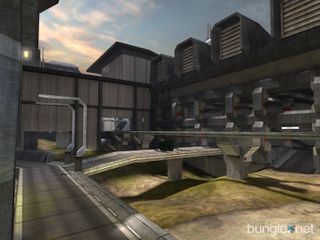
One of the final DLC maps released for Halo 2 in the Maptacular Pack in July 2005 was also one of its most creative. Terminal featured a train that cut through the map, interrupting the action at surprise moments. It's only a mid-sized map, but multiple entrances to the defense's base, verticality, and the train made for dramatic matches.
Chris: I worked on this with Mike Zak who was an environment artist, and I think actually Jaime Griesemer started this map and then he was getting pulled onto Halo 3 so I took it over with Mike. I really liked the idea of the moving objects on Zanzibar and single-flag CTF, designing a map where we focus on that gametype. The attack-defend thing is really interesting. So the layout is relatively simple, where the attackers start at one end and they have this relatively linear approach to the flag. Then we gave the defenders a tank. (Laughs)
We gave the defenders the Wraith but a pretty limited space to use it. I think the attackers had the gauss hog, which only needed a couple hits to take down the Wraith. So it always starts out, the attackers get in the gauss hog, they're rolling down that street, they're gonna try to jump the tracks. Meanwhile, the Wraith has to lob shells, so it's anticipating where they are.
And then the train was this random factor on top of all of it.
Chris: There's the idea of the train tracks being this moving wall that would cut the space off. Originally you could use it as cover, it was supposed to be relatively slow, but as we sped it up and made it this screaming death ball, it got more and more hilarious. The secondary game type was Territories, and the idea of one or two of the territories being on the train tracks was really interesting.
Steve: I remember getting hit by the train. I do remember that.
Chris: The fun thing about DLC is everyone's playing it, because we're just at the very beginnings of our next project. I still remember CTF games on this where the guy is so close to scoring and he has to run across the tracks, and then the train is so instant that he disappears and the flag is just sitting there by itself on the track. It was hilarious.
Terminal gave Carney another chance to design an objective map, his favorite. But Terminal and many other objective-first maps also turned out to be great Slayer maps.
Chris: I always thought [objective maps], from a map design standpoint, were the most challenging, which always made them really interesting problems to solve. Having a gametype that has very specific constraints, as a map designer, gives you some strong constraints to push up against. The more tightly you can define the problem, the more interesting it is to come up with solutions. You can tell really quickly whether something's going to work or not.
Steve: I agree. I think the objective maps, especially capture the flag, it's just something you understand, they were just more interesting to make and design for.
That was such a cool project to work on, and those maps still have a special place in my heart in the amount of time and passion and effort we put into them.
Chris Carney
Chris: I like the idea of almost peeling the onion. As an attacker, even if I die on the way to get the flag but I can still open that gate or drop that bridge, I'm helping the team. I'm helping peel the onion back so we can get deeper and deeper towards the objective. I liked single-flag CTF as well because as the attackers are bringing the flag back, if the defenders can stop them, then it's this really cool problem for defenders. They know they have like 40 seconds before the flag resets, so they have to turn this point into a hardpoint, spread out, cover all these approaches on the fly.
Steve: It's funny, too, because I think the maps that are designed for objectives tend to naturally solve other things that players want, which are just good spaces to understand and come at and fight players in interesting ways.
I remember thinking when you were working on Terminal, it was one of the more complicated maps. Both from the mechanics that were in there, the train, the physics, those gates that go up and down…
Chris: Cause we needed those. (Laughs)
Sometimes the small details ended up taking the most time, like the floating platform on Midship, which Cotton was tuning until the very end of Halo 2's development. The gates on Terminal got just as much attention from Carney.
Steve: That was probably half the time that was spent, is all I'm saying. (Laughs) But not just that stuff, the three dimensional complexity of the environment. It's got a lot more layers than we traditionally did.
Chris: That was such a cool project to work on, and those maps still have a special place in my heart in the amount of time and passion and effort we put into them. I think people ended up liking them. When we finished we weren't like 'Yeah we nailed this!'
We were like, 'Oh God, okay, at least they're not terrible.'
Steve: Let's be honest, Chris is never really satisfied with what we've done. He's always like 'This could be better in some way.' Perfectionist at heart.
Chris: You're similar in your viewpoint...
Steve: We both strive for perfection I think. But if those gates didn't open and close the right way… (Laughs)
Chris: Just so you understand, the parking garage gates [on Terminal] that go up when you get near them—they serve no purpose. But when you go near them they animate and play a little sound. A lot of time got spent.
Steve: Those were good times. I fondly remember all those maps and all the ones that came after that. Both Halo 2 and 3, for me, were amazing.

Wes has been covering games and hardware for more than 10 years, first at tech sites like The Wirecutter and Tested before joining the PC Gamer team in 2014. Wes plays a little bit of everything, but he'll always jump at the chance to cover emulation and Japanese games.
When he's not obsessively optimizing and re-optimizing a tangle of conveyor belts in Satisfactory (it's really becoming a problem), he's probably playing a 20-year-old Final Fantasy or some opaque ASCII roguelike. With a focus on writing and editing features, he seeks out personal stories and in-depth histories from the corners of PC gaming and its niche communities. 50% pizza by volume (deep dish, to be specific).
Most Popular


